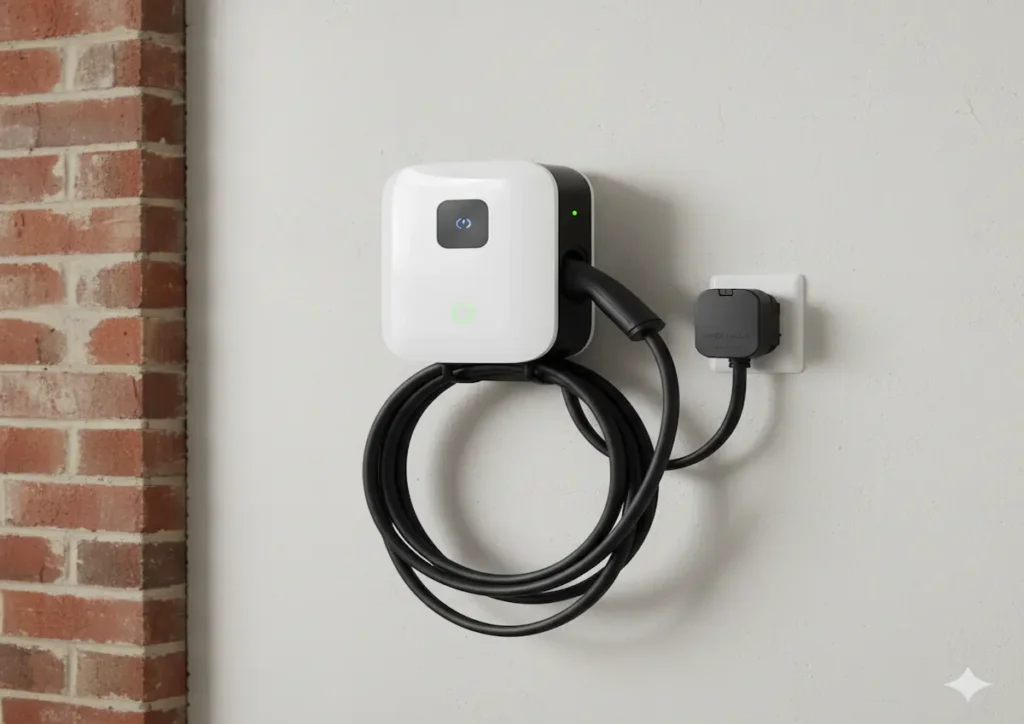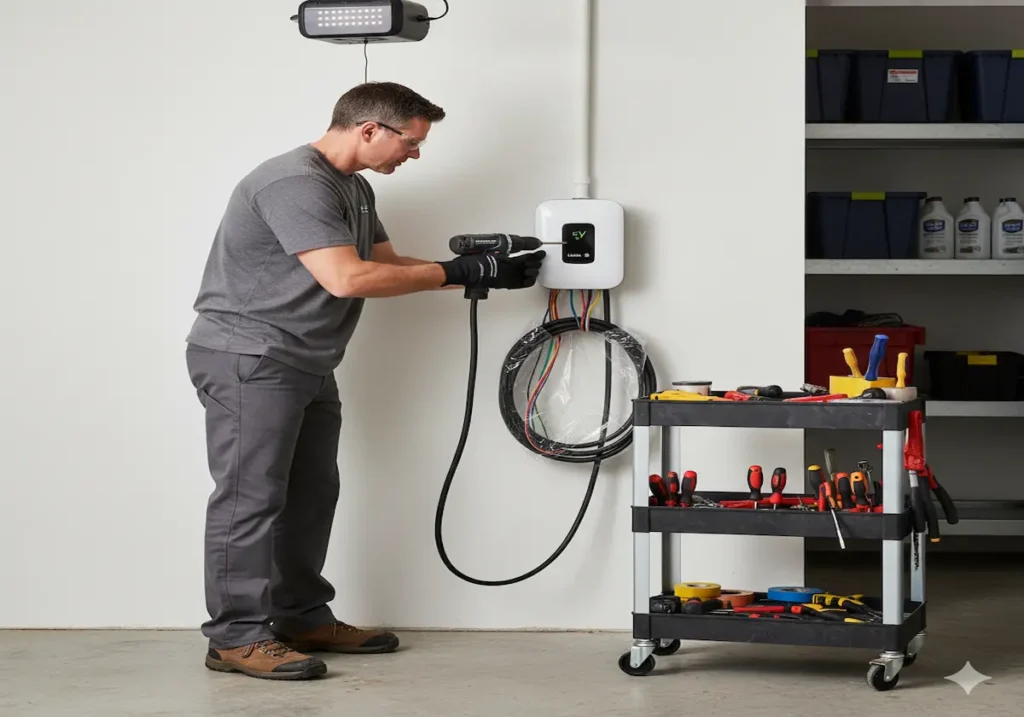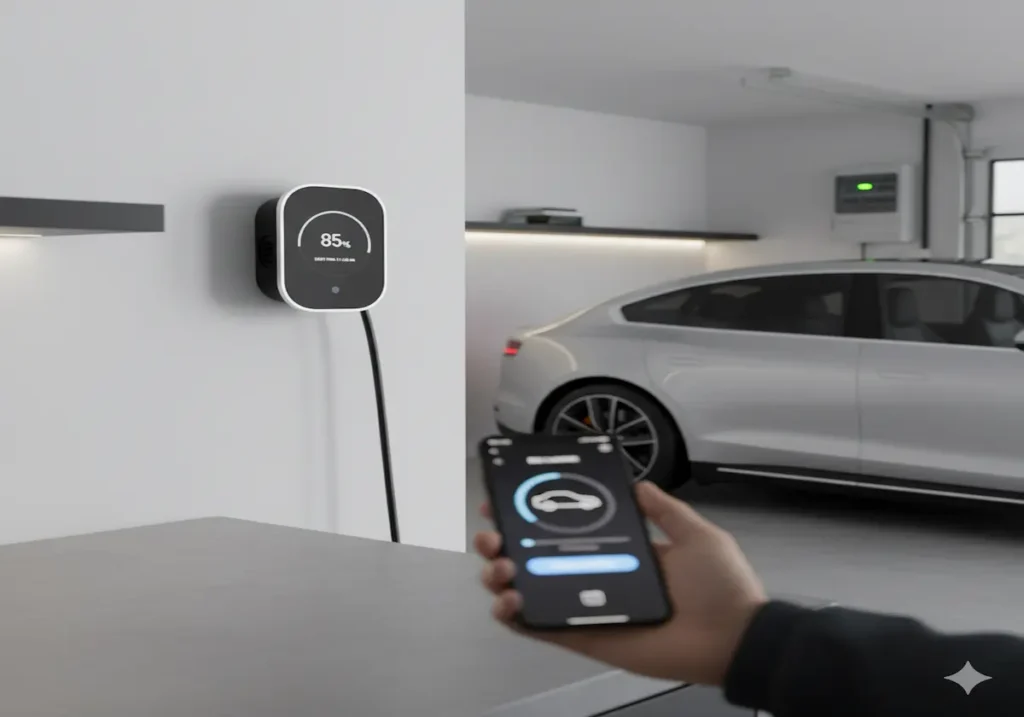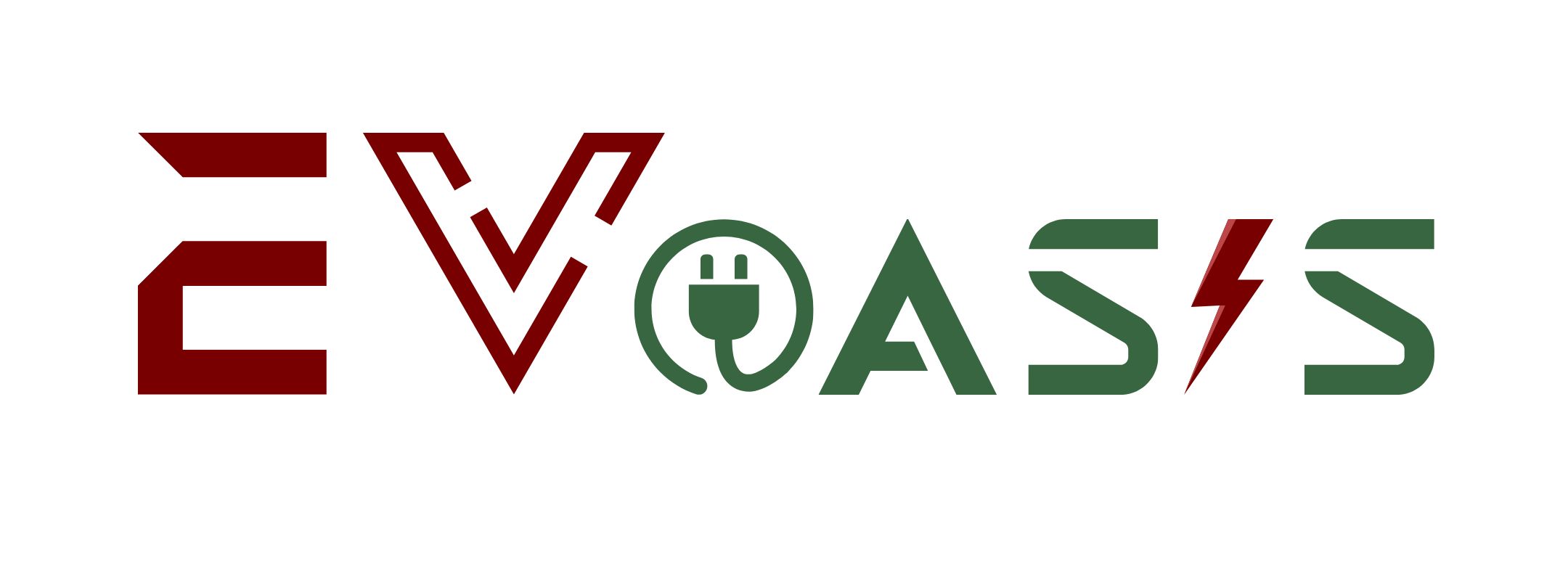Home EV charging is the easiest way to keep your electric car ready to go. You simply plug in overnight and wake up to a full battery every morning. Based on your needs, your charging setup can include wall chargers, portable units, or smart systems that schedule charging times.
We’ve been working with EV technology for years, so we know what it takes to make charging at home both simple and cost-effective.
In this article, we’ll explain the basics of home EV charging, including charger levels and selecting equipment that suits your needs perfectly. We’ll also talk about the EV charger installation process and discuss advanced charging features.
Read on to learn how to get your home EV charger up and running quickly.
Essentials of Home EV Charging
If you want to charge your EV at home, you need to focus on two things: how much power you need and which charger matches your daily requirements.

In this section, you’ll learn about different charger levels first, followed by a discussion on the factors to consider while choosing your EV charger.
Comparing Electric Car Charger Levels
The electric vehicle charger levels show you how fast power flows into your car’s battery. The idea is similar to filling up a water tank. Some taps trickle slowly; others gush out fast.
Now, charger levels range from Level 1 to Level 3, and each level affects your charging time and installation needs. These charging levels help you pick what works for your daily routine.
Let’s break down your main options.
Level 1 Charging for Basic Needs
Level 1 charging plugs straight into your regular wall socket and delivers about 1.8 kW to 2.4 kW of power. However, you only get around 12 kilometres per hour of range, and a full charge takes about 22 hours.
Frankly, Level 1 charging works fine if you mostly take short trips and don’t mind leaving your car plugged in overnight. Also, since most EVs include a Level 1 cable in the box, you can plug in at home and start charging right away without paying for extra setup.
Level 2 Charging for Daily Use
For this, you’ll need a dedicated 240 V circuit for Level 2 charging, and you’ll get 6.2 kW to 22 kW of power through it. Do you know what that extra power means for you? You get 40 to 100 kilometres of range per hour and a full charge in just 4 to 8 hours.
There’s a little catch, though: you’ll need a licensed electrician to install Level 2 systems. Despite it all, most Aussie families find Level 2 very convenient, as it gives them the speed they need.
Plus, the faster charging means you’re free from overnight charging, and you can top up quickly any time you want.
Level 3 Charging for Public Use
With Level 3 charging, you receive 25 kW to 350 kW of power. This DC charging system can charge your car to 80% in about 30 minutes. It sounds amazing for home use, right?
Sadly, Level 3 is unsuitable for most homes. That’s because the installation costs range from $50,000 to $100,000, and your home’s electrical system can’t handle the massive power requirements.
For all these reasons, Level 3 chargers work best at public charging stations where many people can share the costs.
Pro Tip: Keep a backup cable in your boot. Public chargers sometimes don’t include a cable, and carrying your own saves you from getting stuck.
Select the Right EV Charger for Your Needs
Your driving style and home setup play a huge role when you choose a charger, sure. But don’t forget about charging speed, weather durability, and smart features. These factors directly influence how simple and reasonable your charging setup will be (don’t worry, though, it’s not rocket science).
Here are the main factors to consider at the time of picking your home EV charger:
- Charging Speed: Single-phase homes handle chargers up to 7.2 kW, while three-phase properties support up to 22 kW. However, your car’s acceptance rate limits speed too, which is why a 22 kW charger won’t help if your vehicle only accepts 11 kW.
- Weather Durability: In Australia, the weather can be rough on chargers. That’s why you need to pick something with an IP55 rating or higher, so it can handle rain and dust. Also, check the warranty. Good brands usually give you 3 years of coverage, but cheaper models often cut it short.
- Smart Features: You should look for smart features like solar integration, load management, and universal compatibility in your charger. Solar helps reduce power costs, while load management keeps your home safe. And universal compatibility makes the charger useful even if you switch brands.
The EV Charger Installation Process
So, you’ve picked your charger. Now comes the part most people worry about: getting it installed. The installation process includes preparing your home and installing the charger safely.
Honestly, the installation process can feel overwhelming, and we know plenty of drivers think this way. But it gets much easier once you break it into simple steps.

Let’s have a look at the whole EV charger installation procedure from start to finish.
Preparing for Your EV at Home Setup
The preparation phase focuses entirely on checking your home’s electrical system. This is when a qualified electrician must first inspect your existing setup to confirm it can support the new charger without problems.
These are the main areas your electrician will check during the assessment:
- Switchboard Capacity: The home’s main electrical panel must have enough capacity for a new dedicated circuit. The assessment here will prevent overloads and ensure your charger operates safely without disrupting power to other parts of your house.
- Ideal Location: At this stage, the electrician looks at a few things. They check how close your charger is to the switchboard, since shorter distances keep wiring costs down. They also find the best spot for your charging cable to reach the car easily.
- Existing Wiring: Your electrician needs to check that your home wiring meets current Australian standards. For example, if your place is older, you might need upgrades so the wiring can safely handle the sustained high power of a Level 2 charger.
Your home setup could pass every test on paper, but you might still hear buzzing from lights or smell burning plastic unless the electrician upgrades the wiring properly. Keep an eye out for that.
How to Safely Install an EV Charger
Safe EV charger installation starts with choosing a qualified electrician for the job. In other words, you need a licensed electrician who has EV experience and the proper credentials. An expert’s support will keep your setup safe and running reliably for years.
Most importantly, Australian law says only licensed electricians should install an EV charger.
We highly recommend following these steps to ensure a safe and compliant installation:
- Find a Certified Professional: Look for an electrician with specific certifications and experience in EV charger installations. The expertise makes sure they understand unique requirements and safety protocols compared to general electrical work.
- Request a Detailed Quote: It’s important to get a comprehensive quote that lists all costs, including the charger unit, cabling, labour, and any potential switchboard upgrades. That’s because clear pricing helps avoid unexpected expenses when the work finishes.
- Check for Compliance: Your installer must provide a Certificate of Electrical Safety upon completion. This document will prove that your installation meets all local regulations and standards, which affirms safety and legal compliance.
Getting Your Electric Vehicle Fully Charged
On installation day, the job usually takes about 4 hours. During that time, the power will be off, so plan to avoid disrupting your work or daily routine. Also, your electrician will walk you through each step and explain what they’re doing throughout the day.
Now, the installation starts with mounting the charger on the wall. From there, the electrician runs dedicated wiring from your switchboard and hooks everything up to meet Australian safety standards (exactly how you pictured your Saturday, right?).
After putting the charger in, the electrician tests it and verifies that your car and the charger connect without issues. That’s it.
Claiming Rebates for EV Charging Across Australia
Did you know many states and territories, including Western Australia and Tasmania, offer rebates or support for home EV chargers? These programmes lower setup costs and encourage more drivers to go electric.
That’s why we highly recommend checking which incentives apply to you before finalising your budget. That way, you won’t miss out on possible savings and can make a more affordable transition to EV ownership.
Here are more details on state and territory incentives for EV chargers:
- The Northern Territory offers up to $1,000 for a residential EV charger installation and up to $2,500 for a business installation through its Electric Vehicle Charger Grant scheme.
- Tasmania provides 0% interest loans ranging from $500 to $10,000 to help households install EV chargers and other energy upgrades.
- Western Australia (WA) runs the “Charge Up” grant programme, which covers up to 50% of the cost of chargers and installation for eligible businesses and workplaces.
- The Australian Capital Territory (ACT) supports households through its Sustainable Household Scheme. It offers zero-interest loans of up to $15,000, and you can use part of that for EV charger installations.
- New South Wales (NSW) doesn’t offer direct rebates for home EV chargers, but it does run grant programmes for public fast charging, kerbside stations, and EV infrastructure.
- Victoria doesn’t offer home EV charger rebates right now. The state ended its old programmes and now puts money into public charging stations instead. It also pushes new building rules for more homes to be ready for EV wiring in the future.
- Queensland currently doesn’t provide residential EV charger rebates, with previous programmes now closed.
- South Australia (SA) also doesn’t offer rebates for home charger installations, as its earlier EV subsidy ended in 2023.
- The Federal DRIVEN programme helps car dealers and repair shops with charger costs. They can get up to $3,000 back for each smart EV charger, with a cap of $20,000 per site. The idea is to put more chargers where people buy and fix their cars.
Remember that rebate rules change often, so you should always check the latest details before submitting your application.
Smart Ways to Charge Your EV
How can you charge your EV more smartly and save money at the same time? Well, thanks to new tech, you can schedule charging for cheaper off-peak hours. That means a lower power bill, and it makes day-to-day driving less of a pain, too.
Now it’s time to see how you may get the most out of your charger.
Deciding on a Charging Station Cable
You can set up your charger in two ways at home: tethered or untethered. Since the type of charger you choose will influence how you charge your vehicle every day, it’s important to know the difference between these two variants (yup, we’re going on about cables again).
Tethered Chargers
Let’s start with tethered chargers. They come with a cable that stays attached permanently. You just unroll this cable and plug it straight into your car, exactly like using a petrol pump. Most cables stretch 5 to 8 metres, and almost every tethered charger in Australia uses a Type 2 plug that fits all EVs on the market.

Untethered Chargers
Untethered chargers are technically just a socket on the wall with no cable at all. They require you to bring your own cable and plug it in each time.
Yes, untethered chargers are a bit more work, but you get way more flexibility than tethered units. Like, do you want a longer cable, or are you thinking of changing your car later? In either case, just buy a new cable instead of replacing the whole charger, and you’re set.
Pro Tip: Look for weather-resistant cables if your charge point is outside. Sun and rain can wear them out quicker than you think.
Managing Your EV Charging at Home
Most new chargers hook up to your home Wi-Fi and run via a phone app. With this app, you can set your car to charge during specific hours.
Why is that important, though? It’s because Aussie electricity companies now offer special EV deals that make overnight charging super cheap.
For instance, OVO’s EV Plan charges just 8 cents per kWh between midnight and 6 AM. It also gives free power from 11 AM to 2 PM if you have a smart meter.
What’s more, Origin runs its EV Power Up programme that offers an 8-cent rate during scheduled sessions. Right now, this offer mainly works with Teslas, though Origin may expand it to more brands in the future.
Your Path to Hassle-Free Home EV Charging
Charging your EV at home isn’t hard if you take it step-by-step and bring in expert help. That ensures the setup runs safely and meets the rules. Plus, if you add a few of the latest tools to your setup, you’ll save money and make daily charging even simpler.
In this guide, we’ve discussed how charging levels work and how to choose the right charger based on your needs. You also learned about smart features like solar integration and scheduling that save money.
Contact us today at laura@evoasis.com for convenient, cost-effective home EV charging solutions. At EVoasis, we make the EV experience simpler and smoother for Australian homeowners every day.
